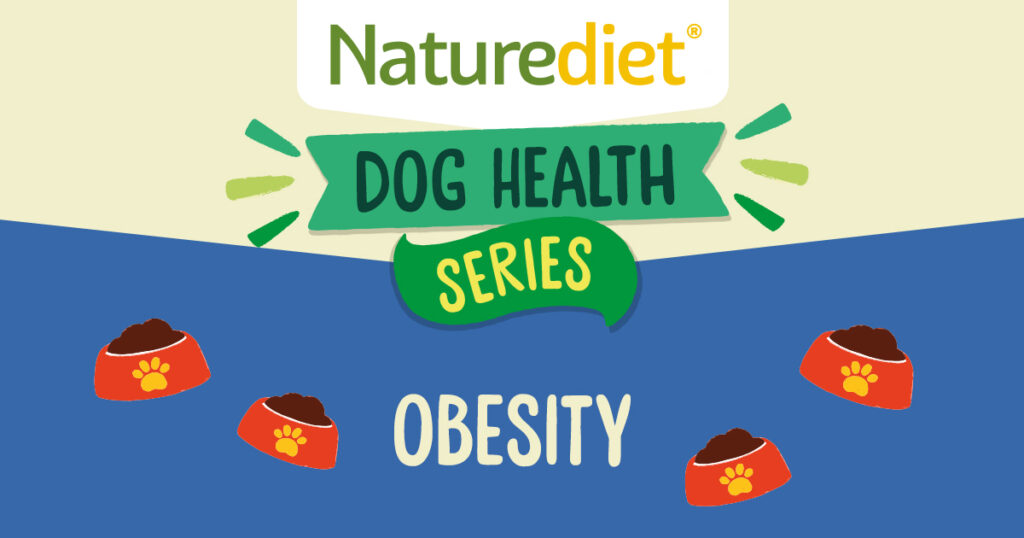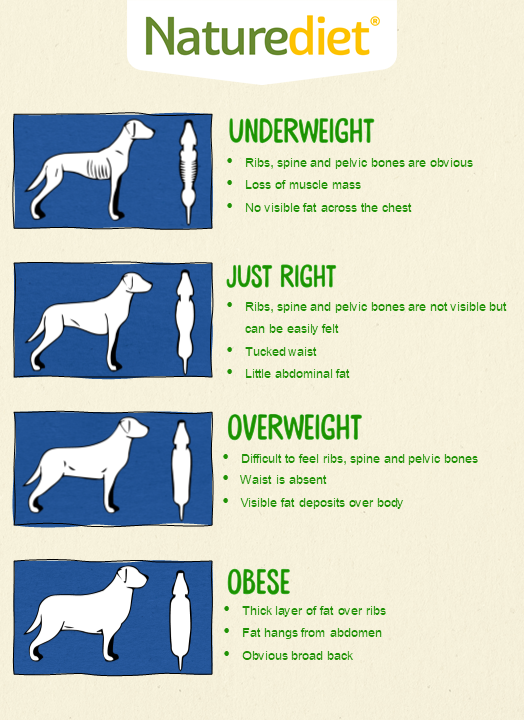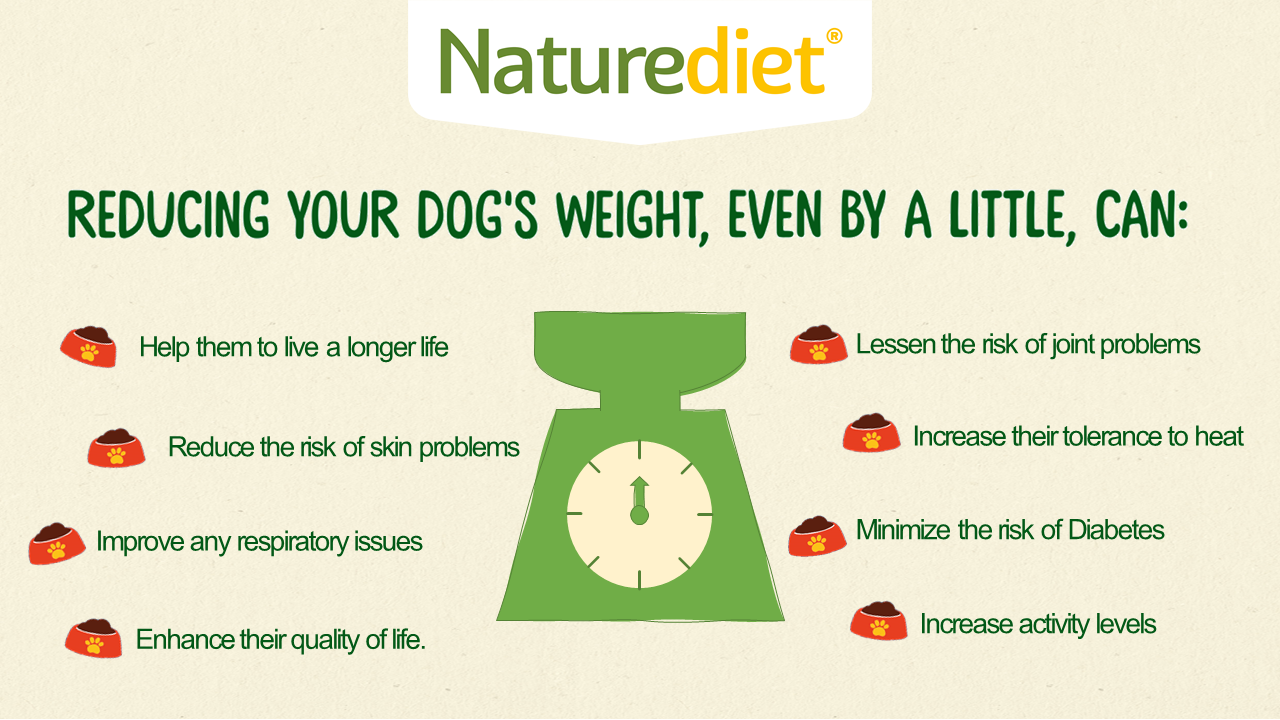Health series – Obesity

Obesity in pets is becoming an increasingly common problem and pets that have weight issues are more at risk from developing health problems such as diabetes, arthritis, cardiovascular and respiratory problems and some cancers. As with humans, it can usually be attributed to an imbalance of how much energy is consumed versus the amount being used. Obesity can also decrease the life expectancy of your pet.
Is your dog overweight or obese?
Dogs, just like people, can easily put on weight. Some people will fail to realise their dog is overweight if he/she has piled on the kilograms over a period of time. Thick or long coats may also disguise the problem.
Body Condition Scoring
Body condition scoring is a convenient method of assessing your dog’s body condition and the amount of body fat. It can help you evaluate (in between having your dog weighed) whether your dog is over or underweight or the correct weight. This involves a visual check as well as a physical check. Run your hands along the length of your dog paying particular attention to your dog’s ribs, spine and hip bones. If your dog is an ideal weight you will be able to feel the ribs, hip bones and spine without an excess of fat covering them.
Depending on how overweight your dog is you may have difficulty in feeling the ribs, spine or hip bones or not be able to feel them at all. If your dog is very overweight there will also be fat deposits over the lower spine and tail base.
If your dog is underweight the ribs may be prominent or will be very easily felt with no fat covering them and the spine and hip bones are visible and easily felt with no or very little fat covering.
Also take a look at your dog from above. Can you see a waist? If your dog is very overweight you will not be able to see a waistline, which is distinguishable if your dog is a normal weight. Dogs that are underweight have a very defined waistline.
Viewing the tummy from the side it should be nicely tucked up if your dog is the ideal weight, however if your dog is overweight the tummy will not have a defined tuck and will be sagging.

Examine and assess your dog on a regular basis but also weigh your dog regularly. Smaller dogs can easily be weighed on bathroom scales by placing them in a basket and subtracting the weight of the basket or by holding them and subtracting your weight. Larger dogs can be weighed at your veterinary surgery.
Why are some dogs overweight?
Diet
One of the main reasons why dogs pile on the kilograms is diet. Overfeeding is a common problem with many owners being unaware that they are feeding their dogs too much. Manufacturers feeding guides are a guide only, and the amount fed should to be adjusted according to whether your dog is gaining or losing weight.
Treats
It is very easy to give in to your dog and feed them extra treats – dogs can be very persistent especially where food and treats are concerned! If you do feed any treats these will need to be taken into account and the amount fed at mealtimes adjusted accordingly. Ideally limit the number of treats and don’t feed human food from the table as this could be higher in calories than dog treats.
Exercise
As with people, it is vital your dog receives daily exercise to reduce the likelihood of obesity. Your dog should go out for a walk at least once a day, but ideally twice a day with some free running off the lead (if safe to do so). Senior dogs will need less exercise. If your dog is fed too much and has little exercise he or she will put on weight. Studies have shown that there are recognised health benefits in walking your dog. If your dog is overweight it is advisable to get them checked by a vet prior to increasing their exercise.
Other Factors
There are a number of other factors that can contribute to weight gain. These include:
Neutering
Medications such as steroids
Diseases such as hypothyroidism, which can affect your dog’s metabolism
Age – older dogs can be less active and need fewer calories
Some breeds are more prone to weight gain such as Labrador Retrievers and Cavalier King Charles Spaniels whereas others such as Greyhounds are less likely to gain weight. Also female dogs are more likely to be overweight than males.
Why is it important not to let dogs get overweight?
Obese dogs are at risk of developing health problems. They are not necessarily happy as their normal life is compromised and they will have difficulty in getting up from lying down. Overweight dogs, just like overweight people, find exercising more difficult becoming more reluctant to exercise and therefore more lethargic. This lethargy will make them even more prone to weight gain.
Overweight dogs have a shorter lifespan and may be predisposed to developing health conditions such as heart and respiratory disease, diabetes, arthritis, urinary disorders and some cancers. Overweight dogs may also have difficulty breathing and being overweight can make existing respiratory diseases worse.
They will also have an intolerance to heat and will find shady places to lie and will pant excessively. They may also be more at risk of heat stroke.
What should you do?
It is important not to let your dog become overweight. It is more difficult to get your dog to lose weight than prevent the weight gain in the first place.
Weigh your dog regularly
Examine your dog on a regular basis and make sure that you can feel the ribs easily without excess fat cover and you can see your dog’s waistline and the tummy is tucked up and not sagging.
Use manufacturers feeding guides as a guide, adjusting the amount you feed according to whether your dog is losing or gaining weight.
Feed your dog twice daily or more so that your dog doesn’t become too hungry between meals. Weigh the food so you know you’re feeding the correct amount of food.
Stop giving treats and don’t feed any food from the table. It is very easy to discount the number of treats fed each day – however, the treats soon mount up!
Ideally keep a diary of everything you feed your dog each day. Document everything you give your dog on a daily basis and don’t cheat by not writing everything down. This allows you to see just how much food your dog is consuming.
Increasing the amount of exercise will help overweight dogs lose weight and also increase their fitness levels. Dogs that rarely go out for a walk and get very little exercise are more likely to gain weight. You will find that the slimmer your dog becomes the more energetic he will become. Find fun ways to play with him in your garden to help increase his exercise as well as taking him/her out for more/longer walks. It is however, very important that your dog is examined by a veterinary surgeon prior to increasing your dog’s exercise.
Do not starve your dog to get him to lose weight and do not decrease the amount of food by too much without first consulting a veterinary surgeon.
Diets
Overweight dogs can benefit from a diet which is lower in calories and fat and higher in fibre. Naturediet Feel Good Senior Lite has been developed for senior dogs or dogs needing to control their weight. It contains a good source of natural fibre which helps keep pets feeling fuller for longer and can be fed to overweight pets.
Feel Good Senior Lite is a complete nutritionally balanced food and doesn’t need to be fed with any other food as it contains all the nutrients your dog needs. You can reduce, or not feed any treats to your dog whilst they are slimming down. You will be amazed how many little treats your dog will have in a day which all contribute to his/her daily calorie intake.
